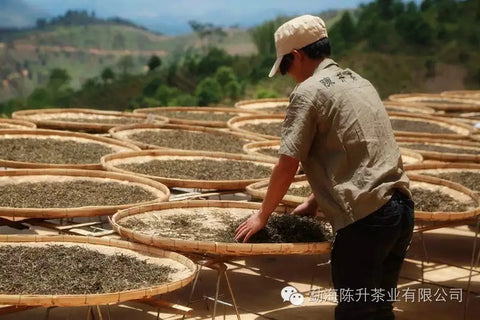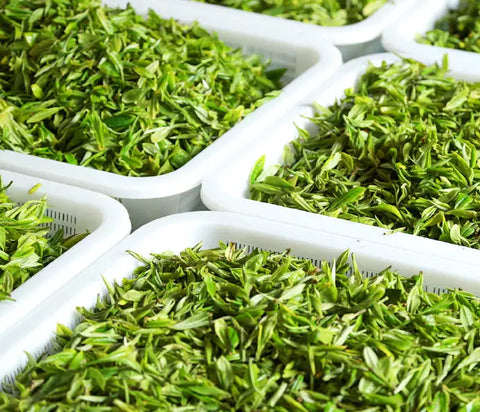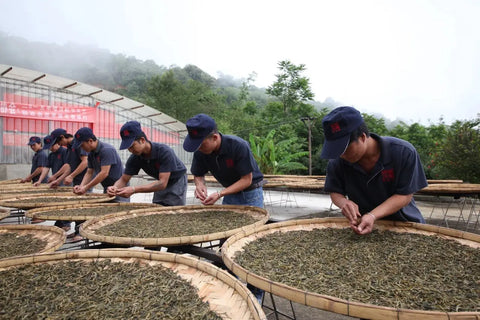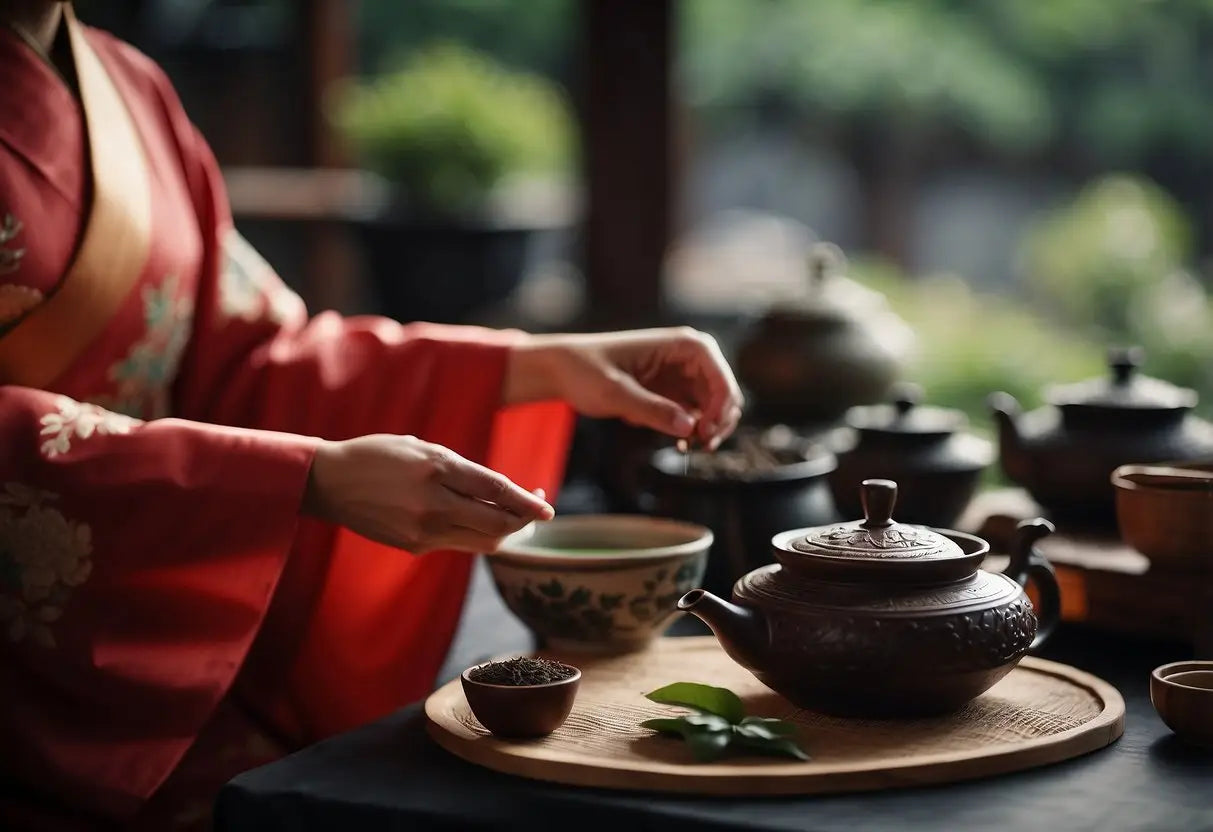Where Is Pu Erh Tea From
Shop our Pu Erh Tea collections!
Pu-erh tea hails from the Yunnan province of China and has a rich history dating back centuries. It is uniquely identified not only by its long cultural heritage but also by its protection under Chinese geographical indications.
Historical Roots
The origins of Pu-erh tea can be traced back to the Han Dynasty (206 BC - 220 AD). It became especially prominent during the Tang Dynasty (618-907 AD) when it was used as a tribute tea to the Chinese emperors. The tea owes its name to the town of Pu'er in Yunnan, where it was historically traded.
Bestsellers
Traditionally, local ethnic groups in Yunnan cultivated and processed Pu-erh tea using ancient techniques. The unique fermentation and aging processes give Pu-erh its distinctive character and deep flavors. Over time, it has gained great prestige and cultural significance.
Geographical Indication
Pu-erh tea's quality and identity are intrinsically linked to its geographic origin. The Yunnan province, with its favorable climate and fertile soil, provides the ideal conditions for growing the large-leaf tea cultivar (Camellia sinensis var. assamica) used in Pu-erh.
In 2008, Pu-erh tea received protection under Chinese geographical indications. This means that authentic Pu-erh must be produced in specific regions within Yunnan. The certification ensures that the unique characteristics of the tea – influenced by local terroir – remain preserved for future generations.
The combination of climate, soil, and traditional methods makes Yunnan an indispensable region for Pu-erh tea production.
Processing Techniques

Pu-erh tea processing begins with harvesting the leaves from the Camellia sinensis plant. These leaves are then withered to reduce moisture content.
After withering, the leaves are pan-fried to halt oxidation. This step is crucial and known as sha qing or "kill green."
Leaves are then rolled to break down cell walls and release essential oils. This step enhances the tea's aroma and flavor.
Post rolling, leaves are subjected to drying. Typically, this is done under the sun, but some manufacturers use low-temperature ovens.
Two main types of Pu-erh tea include raw (sheng) Pu-erh and ripe (shou) Pu-erh.
Raw (Sheng) Pu-erh
- Initial drying: Leaves are left to dry completely.
- Aging: After drying, leaves are pressed into cakes or bricks and aged naturally.
- Flavor: Develops complex flavors over years.
Ripe (Shou) Pu-erh
- Wo Dui (wet piling): Leaves are piled and kept moist.
- Microbial fermentation: Encourages microbial activity, typically lasting 45-60 days.
- Final drying: Leaves are dried and then pressed into shapes.
Both types are stored properly to encourage aging and enhancement of flavors. For sheng Pu-erh, aging can take years, while shou Pu-erh becomes drinkable in months but can also benefit from aging.
Varieties of Pu-erh Tea

Lao Ban Zhang
Pu-erh tea is known for its rich flavors and unique production methods. It comes in different varieties, each offering distinct characteristics and taste profiles.
Raw (Sheng) Pu-erh
Raw Pu-erh, also known as Sheng Pu-erh, undergoes a natural fermentation process. Initially, the leaves are picked, withered, and pan-fried to stop oxidation. They are then sun-dried and compressed into shapes, such as cakes or bricks. Over time, the tea continues to ferment naturally, developing complex flavors and a smoother taste.
Sheng Pu-erh can be aged for decades. As it matures, the tea can shift from astringent and bitter to mellow and sweet. The aging process is similar to wine, where older teas are highly prized. It's ideal if you enjoy fresh, bright, and potent flavors that evolve over time.
Ripe (Shou) Pu-erh
Ripe Pu-erh, or Shou Pu-erh, is created through an accelerated fermentation process. This method was developed in the 1970s to meet the demand for aged Pu-erh. The leaves are fermented in a humid environment for several weeks, similar to composting, which speeds up the aging process.
Shou Pu-erh typically has a dark, rich liquor with earthy, mellow flavors. It lacks the sharp astringency found in younger Sheng Pu-erh. The tea is ready to drink sooner and offers consistent, smooth, and often creamy notes. This variety is perfect for those who prefer deeper, more robust flavors.
Aging and Fermentation

Pu-erh tea goes through a unique aging and fermentation process that enhances its flavor profile and quality. Both aspects are crucial to understanding what makes this tea distinct.
Aging Process
Pu-erh tea is often aged for several years to develop its unique taste. The process can last anywhere from a few months to several decades. The tea is stored in a controlled environment, often with specific humidity and temperature levels.
There are two types of pu-erh: raw (sheng) and ripe (shou). The raw version undergoes a natural aging process, whereas the ripe tea is fermented to accelerate aging. This controlled aging allows the leaves to oxidize slowly, adding complexity to the flavor over time.
Quality control during storage is essential. Factors like the type of storage container and the conditions of the storage environment significantly affect the aging process. Poor storage can lead to mold growth and other issues, which can degrade the tea’s quality.
Impact on Flavor and Quality
The aging process has a profound impact on the flavor and quality of pu-erh tea. As the tea ages, it develops a rich, deep flavor profile. Younger raw pu-erh tends to be more astringent and bitter, while aged varieties become smoother and more mellow.
Fermentation enhances these characteristics by breaking down the tea’s enzymes and altering its chemical composition. This not only adds to the complexity but also boosts the health benefits associated with pu-erh, like improved digestion and reduced cholesterol levels.
In addition to flavor, the texture of the tea changes as it ages. A well-aged pu-erh will have a thicker, more syrupy mouthfeel. The careful balance of aging and fermentation is key to producing high-quality pu-erh tea that can be enjoyed for many years.
Cultural Significance
Pu-erh tea has deep roots in Chinese culture, where it is prized for its unique aging process and health benefits. In modern times, it has gained international recognition, finding its way into both traditional tea gatherings and contemporary tea cultures worldwide.
Traditional Consumption
Traditionally, Pu-erh tea holds a special place in the daily lives of people in Yunnan province. It is often consumed during ceremonial occasions and family gatherings. The aging process, which can last several decades, is a respected practice that enhances the tea's flavor and supposed health benefits.
Pu-erh tea is often presented as a symbol of hospitality and respect. Families may offer their finest aged Pu-erh to honor guests. The storage and aging of Pu-erh tea cakes also serve as a form of investment, sometimes passed down through generations.
Modern Popularity
In recent years, Pu-erh tea has seen a surge in popularity beyond its traditional circles. Health enthusiasts are drawn to its reputed benefits, including digestive aid and weight loss support. It has become a common feature in specialty tea shops and wellness centers.
The global market has embraced Pu-erh tea, with many brands offering aged varieties to cater to international tastes. Its unique flavor profile and perceived health benefits make Pu-erh tea a trendy choice among tea connoisseurs worldwide.
Lists, tables, and bold or italic text are often used in marketing to highlight the tea's key selling points, making Pu-erh a well-advertised product both online and offline.
Health Benefits and Claims

Pu-erh tea is often praised for its potential health benefits. Regular consumption may support several aspects of well-being.
Potential Benefits:
- Digestive Health Drinking pu-erh tea could assist in digestion. Some studies suggest it may help balance gut bacteria.
- Weight Management Certain compounds in pu-erh tea might aid in weight loss efforts. These include antioxidants and some enzymes.
- Cholesterol Reduction Some research indicates that pu-erh tea may help lower LDL cholesterol levels.
Noteworthy Claims:
-
Antioxidant Properties
This tea contains antioxidants which could protect your cells from damage. -
Anti-inflammatory Effects
Some believe that pu-erh tea possesses mild anti-inflammatory properties.
Table of Key Compounds:
| Compound | Potential Effect |
|---|---|
| Catechins | Antioxidant |
| Lovastatin | Cholesterol reduction |
| Polyphenols | Anti-inflammatory, antioxidant |
Always consult a healthcare provider before making significant changes to your diet based on these claims.
Brewing Techniques

To brew Pu-erh tea, start by selecting your teaware. A yixing clay teapot, a gaiwan, or a simple mug will work well.
First, rinse the teaware with hot water to warm it up. This step is crucial as it maintains the brewing temperature.
Take about 3-4 grams of Pu-erh tea leaves and place them into your teapot or mug.
Rinse the Leaves
Pour hot water (around 195-205°F or 90-96°C) over the leaves. Immediately discard this first rinse. This wash helps to awaken the leaves and remove any impurities.
Brewing Time
1st Infusion: Pour hot water over the rinsed leaves. Steep for 20-30 seconds.
2nd Infusion: Steep for 30-45 seconds.
3rd Infusion: Increase steeping time by 10-15 seconds for each subsequent infusion.
Adjust to Taste
Adjust the steeping time and the amount of leaves to suit your taste preference. If the brew is too strong or bitter, reduce the steeping time or use fewer leaves.
Pu-erh tea can be re-steeped multiple times. The flavor evolves with each infusion, offering a unique tasting experience every time.
Global Market and Export
Pu-erh tea has become a significant player in the global market. Originating from China's Yunnan Province, it caters to a growing international demand.
China remains the primary exporter of Pu-erh tea.
Top Importing Countries:
- United States
- Malaysia
- Japan
- Singapore
Pu-erh tea's aging process enhances its value over time, making it a unique product in the tea industry.
The international market for Pu-erh tea is expanding steadily. You can find it in specialty tea shops, online marketplaces, and gourmet stores worldwide.
Export statistics indicate a steady rise in demand, with annual growth rates in certain countries reaching up to 15%.
The price of Pu-erh tea varies widely, influenced by factors like age, quality, and rarity. Aged Pu-erh teas can fetch high prices, especially in markets like Hong Kong and Taiwan.
Popular Forms:
- Loose-leaf
- Compressed cakes
- Tuocha (bowl-shaped)
The global market has also led to increased counterfeit issues, prompting stricter quality controls and certifications.
In the global market, appreciate the genuine quality and rich history of Pu-erh tea. The economic impact of this commodity is substantial, benefiting local producers and the broader industry.
← Older post Newer post →











